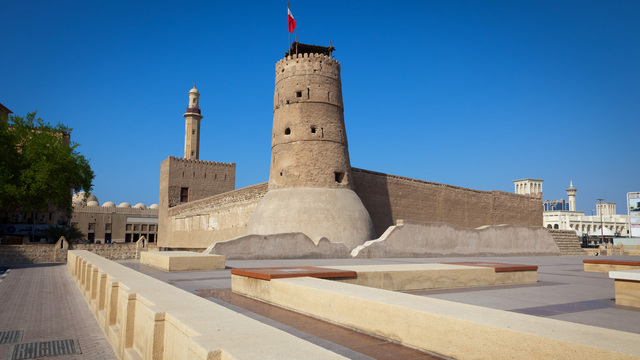Managed by Dubai Culture, these sites represent the legacy of Dubai's historical inhabitants and their interactions with others in the Near East.
Archaeological surveys in Dubai over the years have unearthed numerous sites, including Saruq al-Hadid, Al Sufouh, Jumeirah, and Al Ashoush, among others, revealing the emirate's ancient roots dating back over an astonishing 300,000 years.
From the Lower Palaeolithic (1,500,000-300,000 BC) to the Neolithic period (8000-4000 BC) and up to the late Islamic eras (19th century AD), Dubai boasts over 17 significant archaeological sites that represent the rich and enduring legacy of the emirate's historical inhabitants and their interactions with others in the Near East.
These sites are managed by Dubai Culture and Arts Authority (Dubai Culture) to enhance the emirate's position on the global heritage map.
Let's take a look at these archaeological sites that spread across different emirates:
Saruq al-Hadid archaeological site
One of the most significant sites is the Saruq al-Hadid Archaeological Site (2600-550 BC), discovered in 2002 by Sheikh Mohammed bin Rashid Al Maktoum. It is believed to have been a critical centre for Iron Age metal smelting. It has yielded a treasure trove of rare artefacts, including bronze, pottery, stone vessels, weapons such as daggers and swords, decorative shells, beads made of precious and semi-precious stones, local and foreign seals, and unique gold and silver pieces, showcasing the region's rich history and cultural depth.
Islamic Era Jumeirah site (900-1800 AD)
Discovered in 1969, it dates back to the Abbasid Caliphate era and includes the remains of an ancient Islamic city reflecting the prosperity of Islamic civilisation during the 10th century. It contains 12 archaeological buildings, nine of which are residential, a caravanserai, a mosque, and a market, highlighting the vital role of the Jumeirah area as a significant commercial hub.
Al Sufouh archaeological site (2500-2000 BC)
Discovered in 1988, it contains remains of a settlement dating back to the third millennium BC. Excavations conducted at the site between 1994 and 1995 revealed three earth-cut tombs dating to the Umm Al-Nar civilisation period, containing skeletal remains, copper weapons, stone and pottery vessels, beads, shells, and cylinder seals.
Al Ashoush archaeological site (3rd Millennium BC)
Considered one of the unique archaeological sites discovered in the inland desert area of Dubai, it represents early evidence of human settlements in remote spaces away from the Arabian Gulf coast. The Al Qusais Archaeological Site (2500-550 BC), discovered in the 1970s, contains a large settlement dating to the Bronze and Iron Ages, including a cemetery with about 120 individuals and communal graves, as well as hundreds of artefacts such as metal weapons, pottery and stone vessels, jewellery, beads, shells, and bronze snake models.
Margham archaeological site (1300-600 BC)
Discover last year (In 2023), this site contains a semi-circular-shaped tomb resembling the architectural design of the Hafit era (3200-2500 BC). The tomb includes a skeleton surrounded by several funerary gifts, including soft stone bowls, flintstone cores, a small cup made of bronze, and ten bronze arrowheads.
Jabal Al Yamh Tombs (2500-1300 BC)
The Jabal Al Yamh Tombs in Hatta include 84 tombs scattered beneath the mountain slopes, characterised by their architectural style belonging to the eras of the Hafit, Umm Al Nar, Wadi Suq, and Iron Age civilisations. Numerous artefacts such as pottery vessels, soft stone vessels, decorated shells, copper rings, carnelian, faience, stone, and glass beads were found, revealing significant historical information.
Various sites in Hatta include archaeological sites dating back to the late Islamic Era (17th - early 19th century AD), representing an essential period in Dubai's ancient and modern history.
Suhaila archaeological sites
The Suhaila archaeological sites contain several villages sharing similar architectural elements and building methods, reflecting the prevalent social life at that time. Additionally, the Hatta 'Islamic Village' is a group of houses and a mosque located on a high hill, characterised by support walls and retaining walls dating primarily to the 17th to the 19th centuries AD, serving as a model for the lifestyle of some residents of Hatta during the late Islamic Era.
Wadi Jima site
The Wadi Jima site comprises an Islamic agricultural village dating back to the late Islamic Era, consisting of residential buildings and distinctive agricultural terraces containing a network of complex irrigation channels. The significance of this site lies in its architectural elements, which combine houses and large agricultural terraces, and its valuable engineering, represented by support walls, retaining walls, and dams designed to control rainwater.
#dubai #uaetourism #heritagedubai #travelnews #uaeculture #dubaitourism2024



